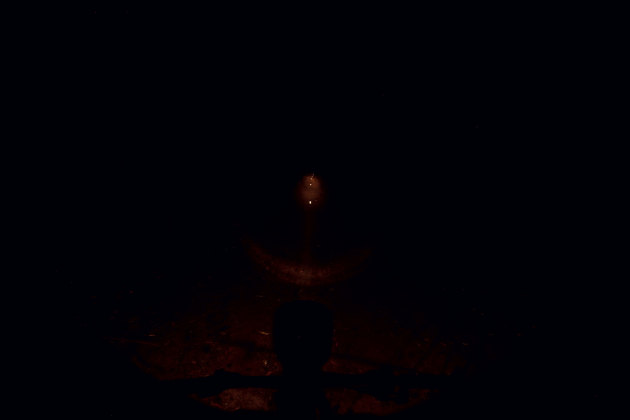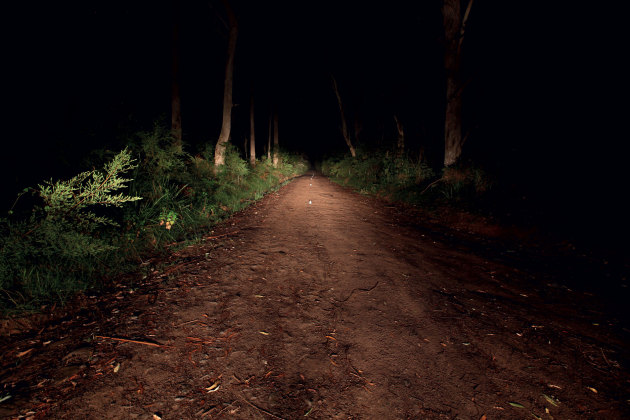LED Lighting - Group Review
Crazy bright off-road lights are nothing new. Five years ago 2-3,000 lumens was cutting edge but now every second light claims this sort of output. Best of all, we’re now seeing real improvements in the more affordable models, and you no longer need to spend $700 to $800 to buy a truly capable MTB light.
Before we get stuck into the reviews, we'll kick off with a couple of photos that will give the MTB lights spome context.
First up we have a $20 Dolphin torch:
Next we have a regular set of 70-watt halogen car headlights on high beam:
- Note: All of our trail photos were taken on the same night using a Canon 5D (16mm lens) with a 10-second exposure at F9 and an ISO of 400. Ten reflectors on the trail are spaced at 10-metre intervals so the furthest is 100 metres away from the light.
Magicshine MJ-900 $89
Magicshine Australia / www.magicshineaustralia.com.au
As a brand, Magicshine is synonymous with affordable lights. Selling for around $89, the MJ-900 clearly fits the bill in this regard. It features a tiny 43g headlight mated to a compact 120g battery.
Such a lightweight and compact light would seem perfect for helmet mounted applications but in stock form the MJJ-900 kit is only set up for handlebar use. You’ll need to purchase a helmet mount separately as well as an extension lead if you plan on stowing the battery in your pack—both items are available through Magicshine for an additional $10 each. With a combined weight of 189g, it’s feasible to mount both battery and light to your head, but this leaves you with a fair bit of wire to bundle up and stow.
As a handlebar light, the MJ-900 is easy to fit. It’s held in place by a stretchy O-ring that’s fixed to a silicone backed stainless steel cradle. It proved quite secure but lacks any side-to-side beam adjustment; something that may prove irritating if your bars sweep back immediately upon exiting the handlebar stem.
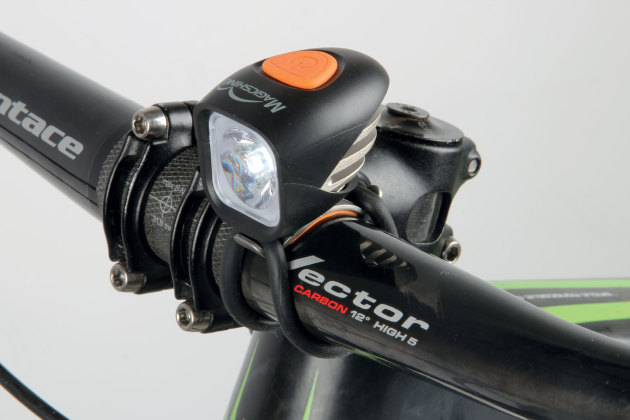
The packaging shouts 1,200 lumens but the online literature makes it pretty clear that this is the ‘theoretical’ lumen output. In reality it’s not the most powerful light but it’s still bright enough for off-road use and would make a lightweight low-cost helmet light to complement a more powerful handlebar light.
The rubberised mode button is large and easy to locate. It scrolls through four light modes; full power, 50% 30% and a flashing mode. A fifth press then turns the light off before you begin the mode sequence again. Having a flashing mode within the main beam cycle can be irritating, but actually having to switch the light off completely before returning to high beam is potentially dangerous when riding off-road. To be fair, the Magicshine Australia website pitches this light as being ideal for road riding, where this type of beam sequence is perhaps a little more acceptable.
Nit-picks aside this is a very tidy light; it’s not at all cheap in its finish. While it’s not super bright, the beam pattern is smooth, relatively wide and easy on the eyes. The 2:40 burntime on full power is also impressive given the compact battery dimensions. The MJ-900 makes a good entry-level or supplementary light.
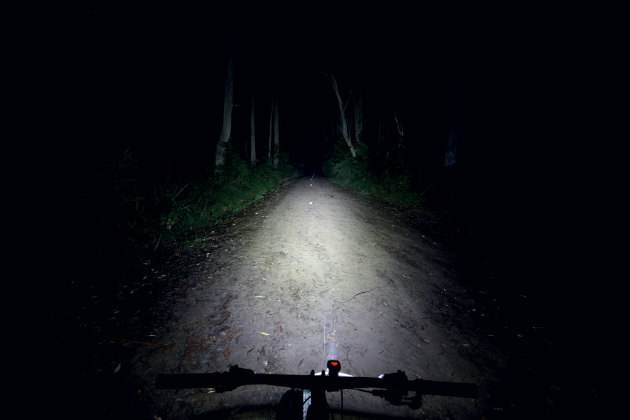
Azur Delux 2000 $149
Bikecorp / www.bicorp.com.au
To be perfectly honest, we’d never heard of Azur lights before. The local importer mentioned they were selling them as an affordable off-road light but we had no idea what to expect. You’ll find tons of relatively unknown light brands coming out of
Asia and it’s near on impossible to pick the screaming bargain from the dubious duds.
In this case the Aussie distributor has done the legwork and offers local backup for the product, but is the Delux 2000 any good as a mountain bike light?
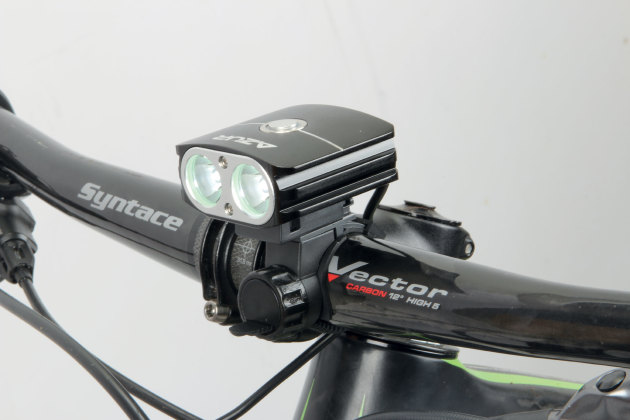
For the modest $149 asking price it comes with both helmet and handlebar fittings, as well as optional rubber O-ring mounts if you prefer. You even get a decent quality carry case for your dollars. While the mounts aren’t the most refined, they do the job and the light never slipped around. The battery is compact enough with a thick foam pad to protect your frame. My only criticism lies with the helmet mount; it makes the light sit up fairly high up and this makes the 153g weight more noticeable than it should be.
Thankfully the operation is very simple with no flashing or moments of total blackness as you cycle through the modes. Just four brightness settings with burntimes ranging from a healthy 3:20 on high up to 22 hours on the lowest setting.
All good so far but how’s the light output? Based on our comparison with a range of other lights, the Azur appears to be just as bright as most others in the 2,000 lumen range. What’s more, the beam quality is very good too. While it’s not the brightest or widest beam, it’s smooth and even with no distracting circles or harsh cut-offs around the outer edge. We’d be happy to see this sort of beam quality on a light that cost twice as much.
All things considered, the Azur Delux 2000 is an exceptionally good light for the money.
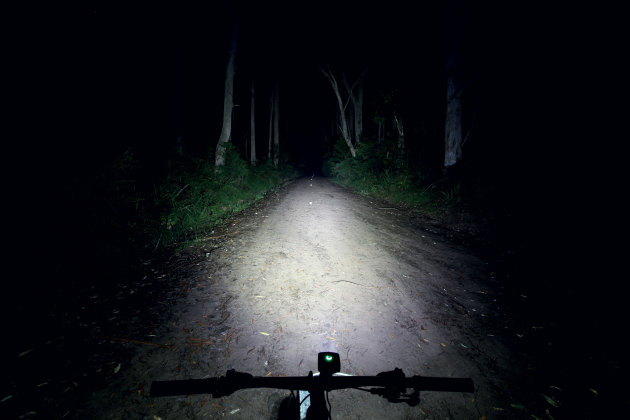
Magicshine MJ-906 $249
Magicshine Australia / www.magicshineaustralia.com.au
Wow, a 5,000 lumen bike light for only $249—now that’s impressive! Magicshine sets some pretty high expectations with their claimed light output but the figure is simply a theoretical one. On the trail the MJ-906 didn’t seem any brighter than most of the 2,000 lumen lights that we had on test. Of course this is still plenty of power for real off-road riding and it’s also entirely respectable given the $249 price tag—just don’t expect it to blow away some of the more modest competition.
The light itself mounts to the bars via a silicone O-ring and a stainless steel cradle. It was quick and easy to use and held the finned alloy light head securely. The battery is quite long but it mounts solidly and maintains a slim profile that made it unobtrusive on most frames. At full power we got a little over two hours from the 7,800mAh battery.

The MJ-906 also comes with a wireless remote switch that can be placed within easy reach of your grips. This was especially handy as the light has a total of five beam settings, including an unavoidable flashing mode. I’d often lose track of which setting I was in—at least the remote makes it all a little easier to manage. While the MJ-906 is supplied as handlebar light, accessories are available for helmet mounting and the remote has enough range to enable mode changes when the light unit is all the way up on your head—cool!
Most LED lights tend to be very ‘white’ but the MJ-906 is a little different. Magicshine has opted for a warmer colour temperature for this light; it’s a little closer halogen light with a slightly orange tinge. While it mightn’t appear as bright, I found the beam did a better job at picking out definition in the trail (especially on darker soils) and it was also less glary in dusty conditions or when riding in the rain.
The beam has an unusual square shape but it worked well enough on the trail—if anything it offered slightly better peripheral vision up close (some of this also comes from the small windows on the side of the light head). Claimed lumens aside, the MJ-906 is very effective on the trail for a $249 light.
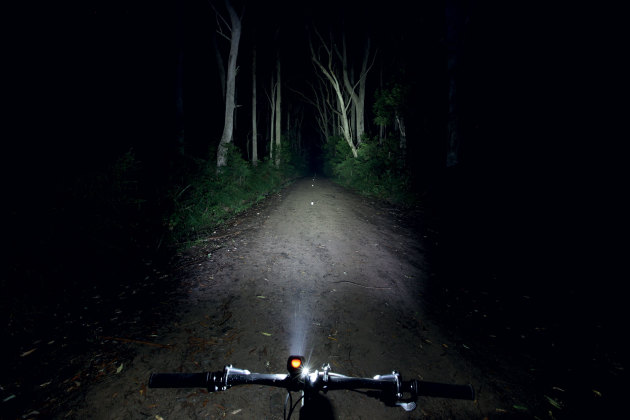
My Tiny Sun Folkslight $259
Full Beam Australia / www.fullbeam.com.au
The Folkslight is a German made all-in-one light and battery system. It’s similar in size and shape to a GoPro, just a little bigger and heavier. It also fits to any GoPro mount, which opens up a myriad of mounting options.
Self-contained lights like this can be great for helmet mounting; there’s no need to stow the battery and you can take your pack off without pulling your helmet off. The only issue here is the weight; at 238g many people will find it too heavy for helmet mounting.
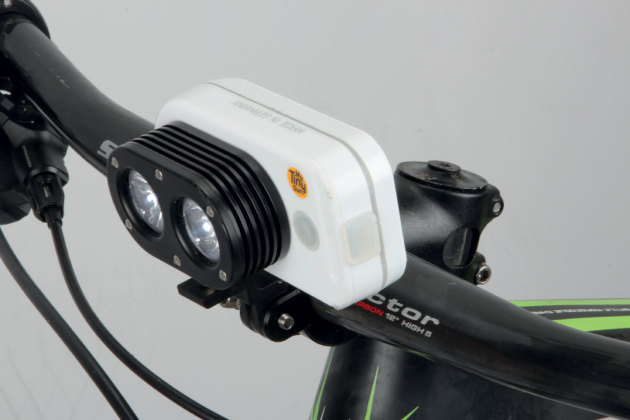
If you can handle the weight, the Folkslight pays you back with its 2,000 lumen light output—it’s a very honest 2,000 lumens too and brighter than most that claim a similar figure. We only know of one other self-contained helmet light that claims a 2,000 lumen output – the Exposure Equinox – but it costs around $100 more and only lasts for 30 minutes at full power. The Folkslight goes for around an hour.
Of course the burntime can be extended with the lower beam settings and the Folkslight can also piggyback off an external battery pack. My Tiny Sun offers adaptor cables that allow you to use an old battery; it just needs to be within the six to 18 volt range.
For handlebar mounting you’ll need a suitable GoPro bracket. The box-like form makes it a little more vulnerable in a crash, so it’s best to opt for a mount that positions the light forward and below the handlebars.
We’ve already mentioned that the Folkslite is very bright but it also ranks highly in beam quality too. One LED has a 31-degree elliptical wide beam while the other is a spot-like 17-degree. They combine to produce a very even output that can be fine-tuned by activating one light at a time. The kit is also supplied with a spare 46-degree lens that lets you tweak the beam pattern further. You can also customise the power outputs with a range of ‘expert’ settings, although we found the stock high/low modes to be ideal for MTB use. In short, the Folkslight delivers a whole lot of German design technology for a relatively modest price.

Exposure Diablo Mk 7 $349
Bike Box (03) 9555 5800 / www.bikebox.com.au
The Diablo is a longstanding member of the Exposure family and rates as their most popular helmet light. This is where their self-contained design comes in particularly handy, as there’s no need to stuff a battery in your back pocket and no cables to deal with.
The whole system weighs 131g—battery and all. Its compact 3,100mAh battery will drive the LEDs at full power (claimed 1,300 lumens) for a touch over an hour. While this mightn’t sound like much, the lower power settings can draw this out to three hours or more whilst still providing a very usable amount of light. Reserve the high beam for the rougher downhills and you’ll happily get a two hour ride from a full charge.
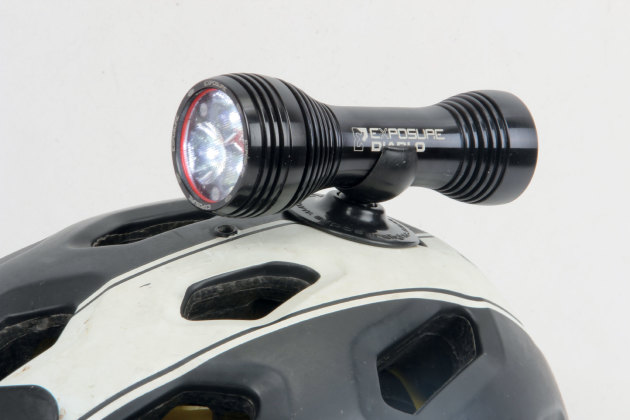
Constant mode swapping can become annoying however, so Exposure has introduced a system that makes it easier. The new Diablo – the seventh edition to be precise – has a feature called Tap Activated Power (TAP). Activate this system and you can change modes by simply tapping the light rather than needing to feel around for the mode button.
Setting up the TAP system was simple enough and you can fine tune the sensitivity (how hard you need to bump it to change modes). I opted for the most sensitive setting and found it worked really well. You could tap the light anywhere; on the lens, the side or back and it would flick across to the next beam setting. In the most sensitive mode you could even tap the helmet itself to change modes yet it wasn’t affected by shaking your head around. Low branches are the clear enemy of this system, so you’d be better off in the manual mode if your night rides take in lots of overgrown trails.
Overall I felt the TAP feature was worthwhile; it made it easier to change modes and would be especially handy if you wear thick gloves in the winter months. Beyond this the Diablo retains all the features from its predecessors; it quickly and easily mounts through your helmet vent and Exposure offers optional external battery packs in case you really need to extend the burntimes further. It’s a compact and handy piece of equipment that will get you out on the trails in a flash.
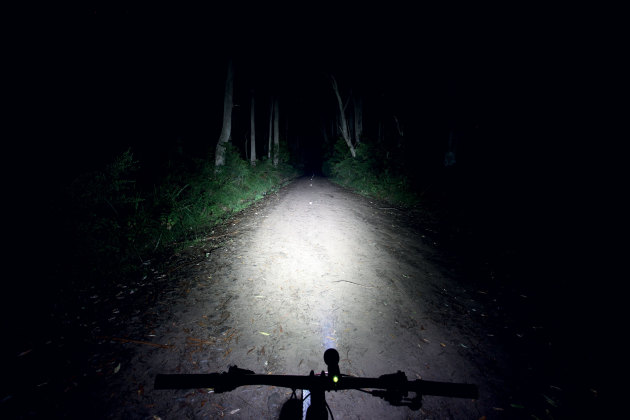
Cycolite Centauri 1700 $399
Bikecorp / www.cygolite.com
This US based company has been in the off-road lighting business for a long time, around 25 years in fact, yet the brand doesn’t seem to attract the fanfare that many others do. They aren’t the most expensive (nor the cheapest), they don’t have models that claim to produce a bazillion lumens and for the most part they’ve stuck with relatively conservative designs. Of course conservative and fluff-free design doesn’t mean they lack in performance.

The Centauri is their top-end model and it’s rated at 1,700 lumens. On the trail it lost nothing to other lights that claim to produce 2,000 lumens. While it offers flashing options for commuting, they’re only accessed in ‘special mode’ so you don’t have to worry about them when riding the dirt. Additionally, the brightness of the four main beam settings can be customised and you don’t need the IQ of Albert Einstein to figure it out. Read the manual once and you’ll be able to tweak the beam outputs as required; there’s no special software or USB plug-ins required.
Both helmet and handlebar mounts are supplied in the kit. While it will work either way, the helmet mount sits towards the front where the weight of the 165g light head is more noticeable. As a result, handlebar mounting was our preference. The tool-free nylon handlebar clamp has two moulded rubber pads that stop it slipping. This is an improvement over their previous designs but the clamp still seems a fraction undersized for most 31.8mm handlebars—we had to remove one of the rubber pads so the bracket would fit.
The beam has a distinct circular pattern that more or less stops in an abrupt line around the outside. This type of beam offers both pros and cons; the contrast around the edge means your eyes will struggle to adjust when looking around the periphery. On the flipside the relatively broad central area flooded with plenty of good even light. We found it worked very well for everything but really twisty low-speed singletrack. The Centauri is a simple yet solid performer.
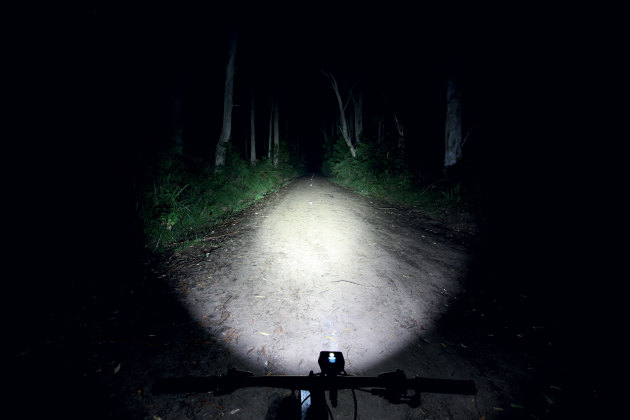
Exposure Toro Mk 7 $475
Bike Box (03) 9555 5800 / www.bikebox.com.au
For some reason the mid-range Toro has always flown under the radar a little. For 2016 however, this compact but relatively powerful light gains the same features as the top-end Exposure models.
Like the 4,000 lumen Six Pack and 2,600 lumen Maxx D, the Toro now sports a digital ‘OLED’ control panel on the back as well as using their auto adjusting Reflex system. So the Toro now incorporates accelerometers that sense whether you’re climbing, descending or hitting bumps and adjust the light output accordingly.
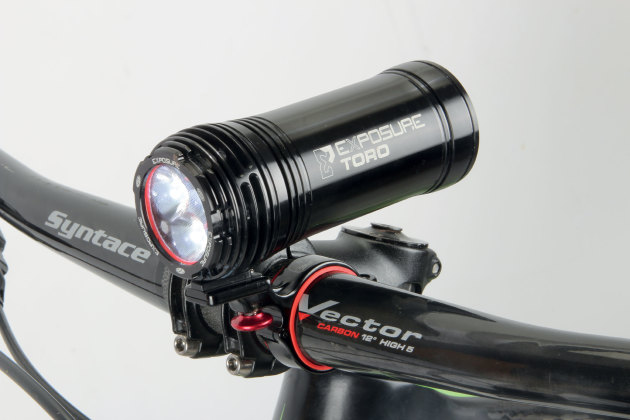
In the most powerful of the Reflex mode, the Toro is said to pump out 2,000 (but that’ll only happen when you’re descending something steep and bumpy). It’s certainly very bright for a lightweight all-in-one handlebar light. The Reflex system works too, although most of the time the changes in light output are relatively subtle. There are three Reflex modes with three, five and 12 hour runtimes. You can also take control if you prefer and control the light manually but not having to take your hands off the bars is a real benefit to some, especially the racer-types out there doing 12 and 24 hour team events.
I really appreciated the digital display. It made the initial setup and beam selection a breeze and the display of your remaining runtime is more user friendly than the usual battery percentage reading.
Compared to the big gun Six Pack that we’ve reviewed previously, the Toro has a narrower beam spread. It’s still very bright however and free from rings and hot spots. As with all Exposure lights, the absolute best thing about them is the complete lack of external wires and separate battery packs. This makes fitting them super fast and convenient—great for those spur of the moment rides where you want to duck out with minimal fuss.
If you’re after maximum convenience and minimal weight but don’t need the wider beam spread of the larger Exposure models, the Toro is worth considering. It packs a whole lot of technology into a very user-friendly package.
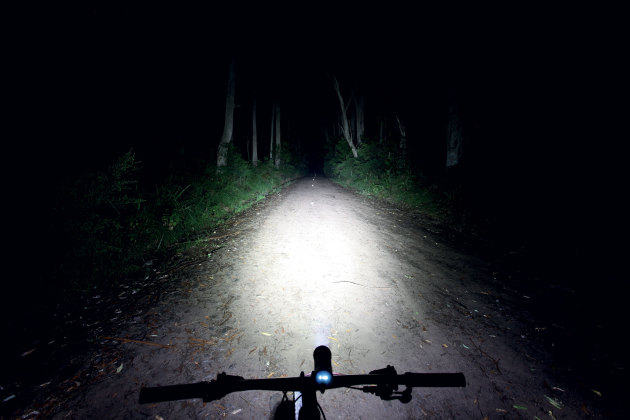
Trail LED XXX $494
Full Beam Australia / www.fullbeam.com.au
With models that pump out as much as 6,000 lumens, the US based Trail LED brand is pretty serious about their off-road lights. The XXX on test here is the baby in the line-up; the three LED light head weighs only 66g (96g including the helmet bracket) and it pumps out 2,000 lumens. According to Trail LED this is an actual measured lumen rating, not the theoretical output that many manufacturers use.

This isn’t the first time we’ve looked at the Trail LED product; last year we tested their five LED ‘DS’ model. Since then they have made a number of updates to make the product easier to use. Previously the light head mounted by big rubber O-rings wrapped through the helmet vents—light, very simple but fiddly to setup. Now they offer a 3D printed nylon fitting that clips the XXX to any Go-Pro mount. There’s also a similar fitting for handlebar mounting. This makes the XXX far easier to fit and the beam angle can be adjusted as you ride. The original O-ring mounting system remains lighter however, with a lower profile against the helmet, but I’d happily use the 30g adaptor for the added convenience.
What hasn’t changed is the high quality finish. The all-alloy light head is made by Industry Nine in the US and machining is immaculate. Last year the battery was simply wrapped in rubber but now it’s inside a neoprene bag; not super-flash but it works.
With its minimal weight and low profile, the XXX is a fine candidate for helmet mounting. The beam pattern reflects this intention too. It’s very bright for a 2,000 lumen light and most of this power is fired straight down the guts of the trail. It offers exceptional distance vision making it ideal for high-speed descents. The beam is also very smooth and even, although it does peter out quickly to the sides—such is the nature of a narrow beam light.
We also have to say that we loved the simplicity of this light. The raised button is easy to locate with a light touch. Switch it on and you get a simple low/high beam setup that’s really all you need 90% of the time. It does offer a range of flashing and other modes but they don’t interfere with the regular on-the-trail beam settings—just how it should be!
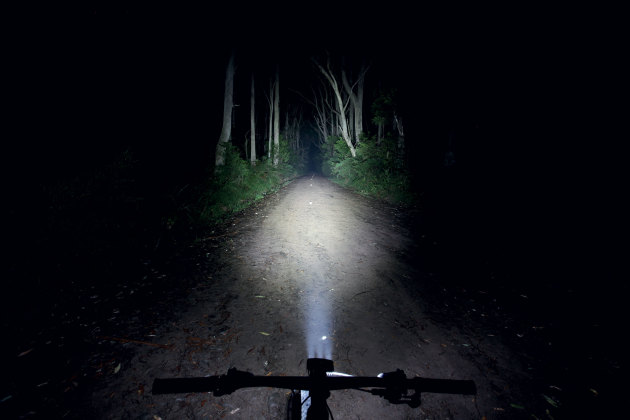
Four4th Holy Moses $529
Full Beam Australia / www.fullbeam.com.au
A relatively new brand to the Australian market, Four4th are made in the UK and offer a range of interesting features. Their Holy Moses is pitched mainly as a handlebar light but it can be ordered with a range of different mounting options.
The standard $529 Holy Moses kit comes with independent battery and light mounting brackets. Each bracket is made from engineered nylon and allows for fast and easy mounting. The frame mount is particularly neat; it straps on with a heavy duty O-ring and the battery keys in with a twist-and-lock motion and a pin that ensures it can’t go anywhere.
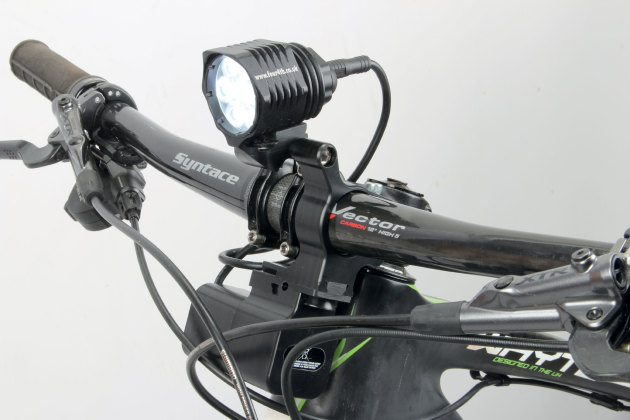
While the stock mounts did the trick, their integrated mount was very clever and provides a solution for odd frame designs that don’t have a good battery mounting point. As you can see in the photos, the one handlebar bracket holds both the battery and the light head. We tried it on a number of bikes and there was enough adjustability to make it fit just about any setup—even with a short stem. This mounting option adds $15 to the price and it’s available to suit 31.8 and 35mm handlebars.
A range of battery capacities are offered; our kit came with a compact 3,400mAh unit that gave us a touch under two hours at full power, it then drops back to a more conservative power setting that will get you home if required. A large easy to use button lets you access the three regular power settings and there are no distracting flashing modes unless you want them.
Best thing about the Holy Moses was the actual light output. This 2,500 lumen light isn’t just bright, the standard 21-degree beam also offers a very wide and even spread of light. It mightn’t look as bright as an equivalent narrow beam light but it’s much easier on the eyes and far better for handlebar mounted applications. Four4th offers an 11 degree and a super wide 33 degree flood beam too, so there are plenty of options. Finally, the LED chips are and batteries are all replaceable; this means you can upgrade your light as technology develops—a rare feature in an increasingly disposable world.
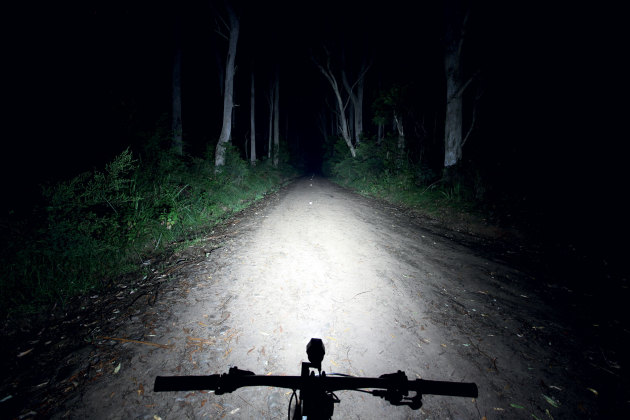
Summary Table:






